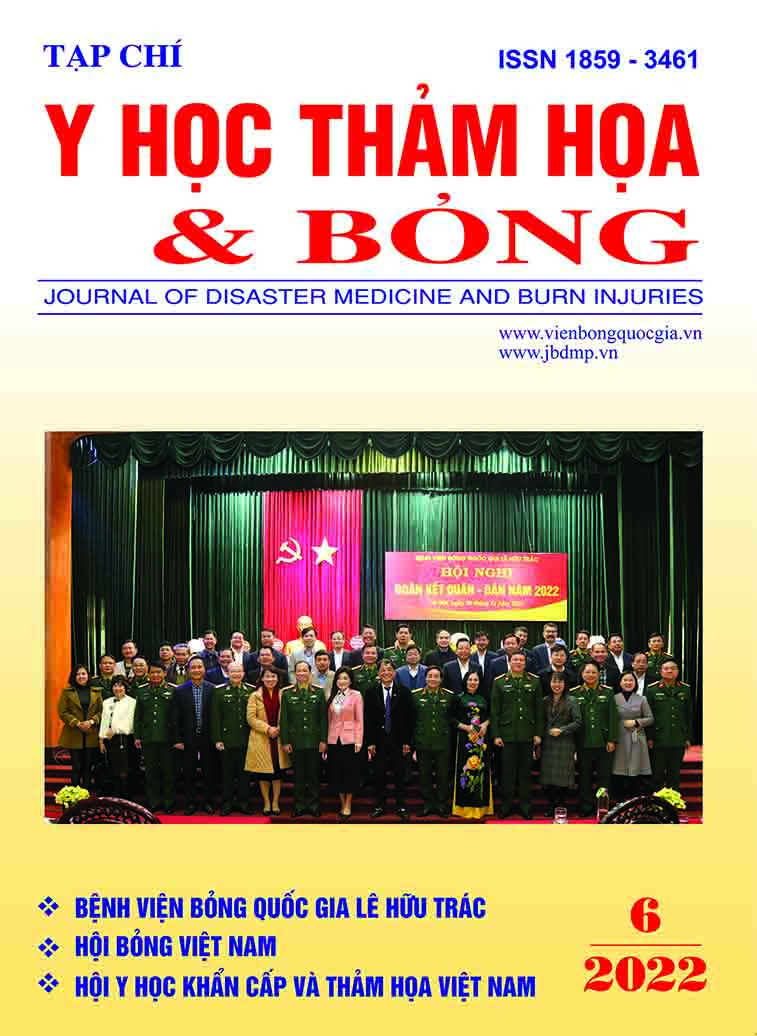Initial evaluation of the effectiveness of prone position ventilation for treating acute respiratory distress syndrome in patients with severe burns
Main Article Content
Abstract
Introduction: In patients with severe ARDS, prone-position ventilation is thought to be effective in improving air exchange and safe.
Objectives: To evaluate the effectiveness of improving blood oxygenation and lung mechanics after prone position ventilation, the safety of the treatment, and its outcomes.
Subjects and methods: A prospective comparative study was conducted on 14 adult burn patients with ARDS, treated in the Intensive care unit at the National Burn Hospital, from 8/2021 to 10/2022. Indicators include blood oxygenation; lung mechanics before, during, and after prone position ventilation. Clinical criteria: Accidents, complications during the ventilation process, and the outcomes of prone position ventilation.
Results: The average burn area was 53.92 ± 21.05%, mean deep burn area was 27.07 ± 14.75%. There were six out of 14 patients with an inhalation injury. During the prone position ventilation process, blood oxygenation improved over time, and the PaO2/FiO2 ratio increased gradually compared with before ventilation (p < 0.05). Static lung compliance increased sharply after prone-position ventilation, from 22.5 ml/cmH2O to 25.36 ml/cmH2O (p < 0.05). Peak airway pressure, plateau pressure, and mean airway pressure decreased significantly after prone position ventilation (p < 0.05). Prone position ventilation was quite safe: no patients underwent hypotension, cardiac arrest, endotracheal tube obstruction, or slip of the endotracheal tube; one patient had a slip of a central venous catheter (7.14%), and six patients had facial edema (42.84%). The rate of improved oxygenation in patients was high (85.72%), and the mortality rate was 64.3%.
Conclusion: Prone position ventilation was effective in improving blood oxygenation, and lung mechanics and safe for patients with severe ARDS.
Article Details
Keywords
Prone position ventilation, burns, ARDS
References
2. Guerin C, Reignier J, Richard JC, et al (2013). Prone positioning in severe acute respiratory distress syndrome. N Engl J Med; 368(23): 2159-2168.
3. Đỗ Minh Dương (2017) Nghiên cứu sự thay đổi oxy hóa máu và cơ học phổi trong thông khí nhân tạo tư thế nằm sấp trên bệnh nhân suy hô hấp cấp tiến triển, Luận án tiến sỹ y hoc, Đại học Y Hà Nội.
4. Romero CM, Cornejo RA, Galvez LR, et al (2009). Extended prone position ventilation in severe acute respiratory distress syndrome: a pilot feasibility study. J Crit Care; 24(1): 81-88.
5. Hale et al (2012). Prone positioning improves oxygenation in adult burn patients with severe acute respiratory distress syndrome. Journal of Trauma and Acute Care Surgery; 72(6): 1634-1639.
6. Pelosi P, Tubiolo D, Mascheroni D, et al (1998). Effects of the prone position on respiratory mechanics and gas exchange during acute lung injury. Am J Respir Crit Care Med; 157(2): 387-393.
7. Gattinoni L, Tognoni G, Pesenti A, et al (2001). Effect of prone positioning on the survival of patients with acute respiratory failure. N Engl J Med; 345 (8): 568-573.
8. Nakos G., Tsangaris I., Kostanti E., et al. (2000) Effect of the prone position on patients with hydrostatic pulmonary edema compared with patients with acute respiratory distress syndrome and pulmonary fibrosis. American journal of respiratory and critical care medicine, 161 (2), 360-368.
9. Guérin C. (2014) Prone ventilation in acute respiratory distress syndrome. European Respiratory Review, 23 (132), 249-257.
10. Munshi L., Del Sorbo L., Adhikari N K., et al (2017). Prone position for acute respiratory distress syndrome. Annals of the American Thoracic Society; 14(4): 280-288.


